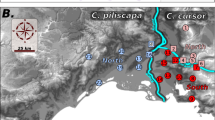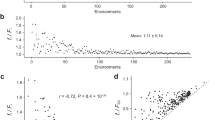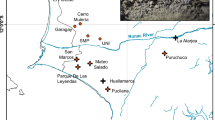Abstract
Isofemale lines of the cactophilic species, Drosophila buzzatii, exhibit genetic variation for their oviposition response to cactus yeast species in the laboratory. In general, interactions between yeast species preclude the use of pairwise preferences as predictors of preferences in three-way choice experiments. Two isofemale lines with relatively high laboratory preference for ovipositing on the yeast Pichia cactophila (as opposed to Cryptococcus cereanus) and two isofemale lines with relatively low preference for P. cactophila were used in a series of field release experiments to determine if laboratory preferences were also realized under field conditions. The influence of yeast species on both settling behaviour (long-distance response) and oviposition preference (short-distance response) were tested. The four lines were identical in their settling behaviour, preferring P. cactophila. The analysis of the oviposition preference tests showed significant line effects which correlated with the laboratory results. Thus a genetic component for oviposition preference under laboratory and field conditions was demonstrated and this strengthens the evidence for genotype-specific habitat selection in D. buzzatii. One low line, however, did not differ significantly from the two high lines under field conditions. A laboratory retest of this low line showed that the laboratory preference had not changed. The reason for the difference in the two situations is unknown but undoubtedly is attributable to uncontrolled variables under the field situation. Settling behaviour and oviposition response, in general, appear to be proximately linked to differences in the volatiles produced by the different yeast species.
Similar content being viewed by others
Article PDF
References
Armstrong, T P. 1992. Olfaction and habitat selection in Drosophila buzzatii. Ph.D Thesis, University of New England, Armidale.
Barker, J S F. 1992. Genetic variation in cactophilic Drosophila for oviposition on natural yeast substrates. Evolution, 46, 1070–1083.
Barker, J S F, East, P D, Phaff, H J, and Miranda, M. 1984. The ecology of the yeast flora in necrotic Opuntia cacti and of associated Drosophila in Australia. Microbial Ecol, 10, 379–399.
Barker, J S F, Starmer, W T, and Vacek, D C. 1987. Analysis of spatial and temporal variation in the community structure of yeasts associated with decaying Opuntia cactus. Microbial Ecol, 14, 267–276.
Barker, J S R, Toll, G L, East, P D, Miranda, M, and Phaff, H J. 1983. Heterogeneity of the yeast flora in the breeding sites of cactophilic Drosophila. Can J Microbiol, 29, 6–14.
Carson, H L, and Ohta. A T. 1981. Origin of the genetic basis of colonizing ability. In: Scudder, G. G. E. and Reveal, J. L. (eds) Evolution Today, pp. 365–370. Carnegie-Mellon University, Pittsburgh.
Courtney, S P, and Chen, G K. 1988. Genetic and environmental variation in oviposition behavior in the mycophagous Drosophila suboccidentalis Spcr. Funct Ecol, 2, 521–528.
Diehl, S R, and Bush, G L. 1989. The role of habitat preference in adaptation and speciation. In: Ott, D. and Endler, J. A. (eds) Speciation and its Consequences, pp. 345–365. Sinauer, Sunderland, MA.
Fellows, D P, and Heed, W B. 1972. Factors affecting host plant selection in desert-adapted cactiphilic Drosophila. Ecology, 53, 850–858.
Fogleman, J C. 1982. The role of volatiles in the ecology of cactophilic Drosophila. In: Barker, J. S. F. and Starmer, W. T. (eds) Ecological Genetics and Evolution The Cactus-Yeast-Drosophila Model System, pp. 191–206. Academic Press Australia, Sydney.
Fogleman, J C, and Abril, J R. 1990. Ecological and evolutionary importance of host plant chemistry. In: Barker, J. S. E, Sarmer, W. T. and Maclntyre, R. J. (eds) Ecological and Evolutionary Genetics of Drosophila, pp. 121–143. Plenum, New York.
García-Dorado, A. 1986. The effect of niche preference on polymorphism protection in a heterogeneous environment. Evolution, 40, 936–945.
García-Dorado, A. 1987. Polymorphism from environmental heterogeneity: some features of genetically induced niche preference. Theor Pop Biol, 32, 66–75.
Griffing, B. 1956. Concept of general and specific combining ability in relation to diallel crossing systems. Aust J Biol Sci, 9, 463–493.
Hedrick, P W. 1990a. Genotypic-specific habitat selection: a new model and its application. Heredity, 65, 145–149.
Hedrick, P W. 1990b. Theoretical analysis of habitat selection and the maintenance of genetic variation. In: Barker, J. S. F., Starmer, W. T. and Maclntyre, R. J. (eds) Ecological and Evolutionary Genetics of Drosophila, pp. 209–227. Plenum, New York.
Heed, W B. 1971. Host plant specificity and speciation in Hawaiian Drosophila. Taxon, 20, 115–121.
Hoffmann, A A, and Parsons, P A. 1988. The analysis of quantitative variation in natural populations with isofemale strains. Génét Sél Évol, 20, 87–98.
Hoffmann, A A, Parsons, P A, and Nielsen, K M. 1984. Habitat selection: olfactory response of Drosophila melanogaster depends on resources. Heredity, 53, 139–143.
Jaenike, J. 1985. Genetic and environmental determinants of food preference in Drosophila tripunctata. Evolution, 39, 362–369.
Jaenike, J. 1986. Genetic complexity of host-selection behavior in Drosophila. Proc Natl Acad Sci USA, 83, 2148–2151.
Jaenike, J, and Holt, R D. 1991. Genetic variation for habitat preference: evidence and explanations. Am Nat, 137, S67–S90.
Klaczko, L B, Taylor, C E, and Powell, J R. 1986. Genetic variation for dispersal by Drosophila pseudoobscura and Drosophilapersimilis. Genetics, 112, 229–235.
Lofdahl, K L. 1986. A genetic analysis of habitat selection in the cactophilic species, Drosophila mojavensis. Huettel, M. D. (ed.) Evolutionary Genetics of Invertebrate Behavior, pp. 153–162. Plenum, New York.
Maynard Smith, J. 1970. Genetic polymorphism in a varied environment. Am Nat, 104, 487–490.
Orians, G A. (ed.) 1991. Habitat selection. Am Nat, 137, S1–S130.
Raushek, M D. 1984. The evolution of habitat preference in subdivided populations. Evolution, 38, 596–608.
Rosenzweig, M L. (ed.) 1987. Habitat selection and evolutionary processes. Evol Ecol, 1, 283–407.
Sokal, R R, and Rohlf, F J. 1981. Biometry. W. H. Freeman & Co., San Francisco.
Starmer, W T, and Barker, J S F. 1986. Ecological genetics of the Adh-1 locus of Drosophila buzzatii. Biol J Linn Soc, 28, 373–385.
Taylor, C E. 1976. Genetic variation in heterogeneous environments. Genetics, 83, 887–894.
Templeton, A R, and Rothman, E D. 1981. Evolution in finegrained environments. II. Habitat selection as a homeostatic mechanism. Theor Pop Biol, 19, 326–340.
Author information
Authors and Affiliations
Rights and permissions
About this article
Cite this article
Barker, J., Starmer, W. & Fogleman, J. Genotype-specific habitat selection for oviposition sites in the cactophilic species Drosophila buzzatii. Heredity 72, 384–395 (1994). https://doi.org/10.1038/hdy.1994.55
Received:
Issue date:
DOI: https://doi.org/10.1038/hdy.1994.55
Keywords
This article is cited by
-
Behaviour genetics ofDrosophila: Non-sexual behaviour
Journal of Genetics (2005)
-
Size-related sexual selection and yeast diet inDrosophila buzzatii (Diptera: Drosophilidae)
Journal of Insect Behavior (1996)



